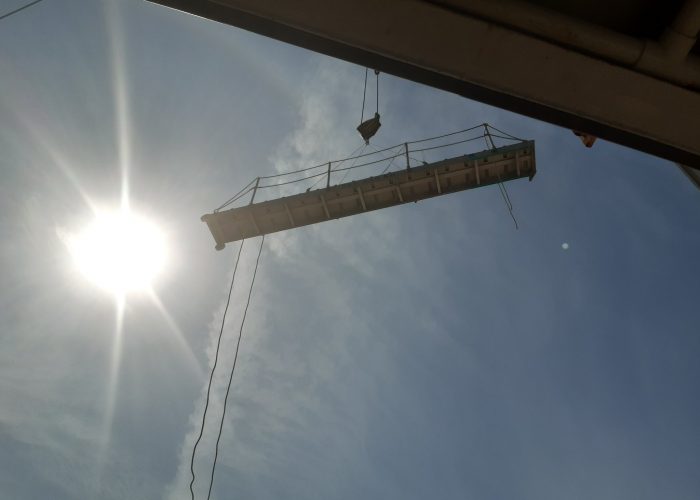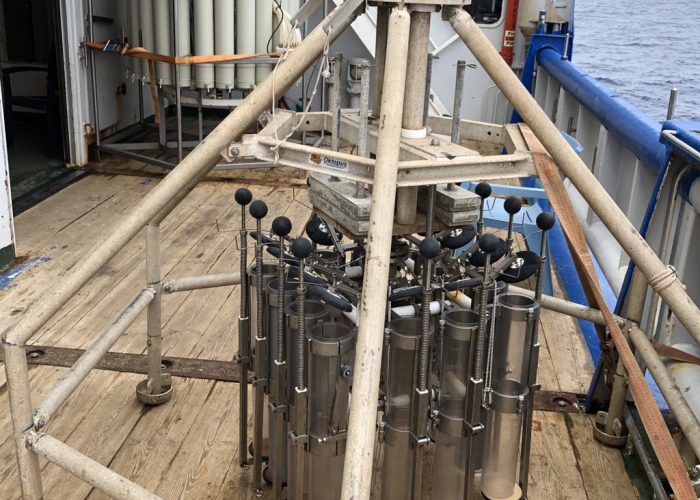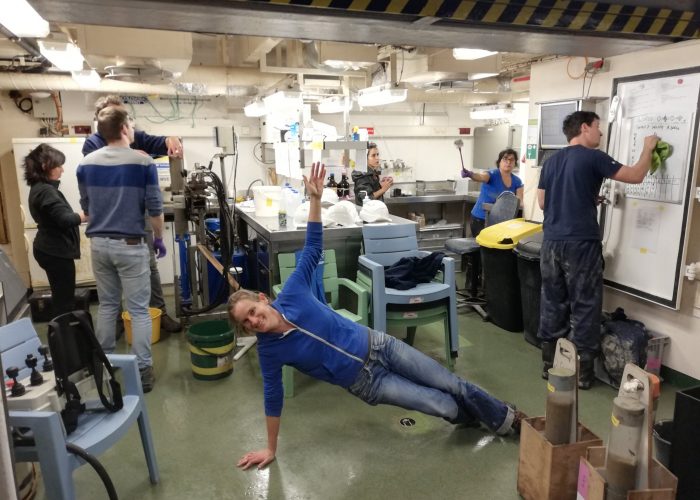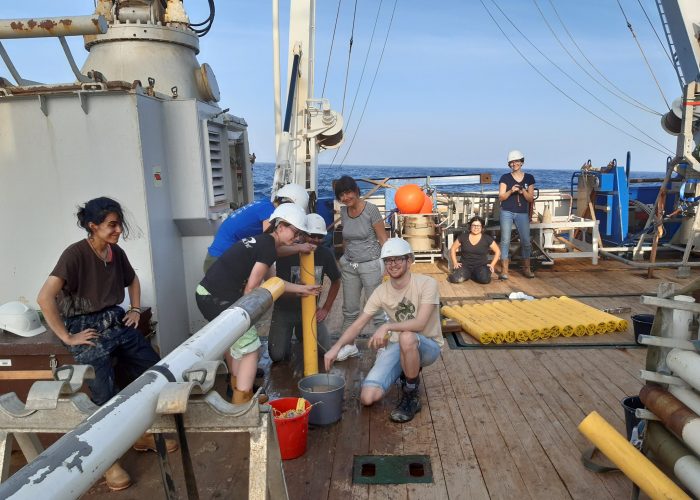Blog: Gulf of Mexico Cruise, 2020
Every year, the mighty Mississippi river and its distributaries carry vast amounts of sediments and nutrients into the northern Gulf of Mexico, impacting the chemistry and biology in the water and the seafloor of the region and triggering algal blooms.
This month, NESSC-researchers Francien Peterse, Francesca Sangiorgi, Laura Pacho Sampedro and Yord IJedema, with NIOZ colleagues Rick Hennekam and Alena di Primio, set out on an expedition into the Gulf of Mexico, aboard research vessel Pelagia. The Gulf of Mexico cruise aims to improve understanding of the impact of large delta systems on the coastal ecosystem in the present and past, and assess the fate of soil organic carbon and nutrients discharged by the Mississippi River.
In the below blogposts, the scientific crew share their experiences aboard the RV Pelagia!
Day 1 – by Rick Hennekam
Day 2 – by Yord IJedema
Day 5 – by Francesca Sangiorgi
Day 6 – by Alena di Primio
Day 8 – by Torbjörn Törnqvist
Day 17 – by Laura Pacho
Day 19 – by Francien Peterse
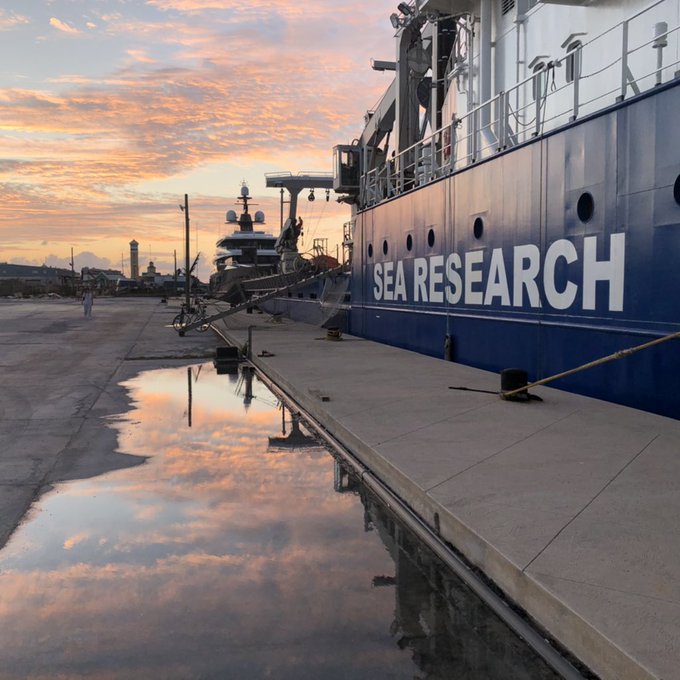
Day 1: February 1 – by Rick Hennekam, paleoceanographer at Royal NIOZ
Transit to Texas
We’re on the move. Yesterday we left from the Bahamas towards the southeastern coast of Texas, starting our adventure to study the water column and sediment archive in the northern Gulf of Mexico (GoM). From the Texas coast, we will gradually move in eastern direction along the coast of Louisiana to visit study sites with depths ranging from 20 meters to 3200 meters. Onboard are nine scientists, who heavily rely on the support provided by eleven dedicated crew members and two technical engineers on Research Vessel (R/V) Pelagia. Everyone is very eager to start, yet, as the ship moves with a speed of about 9 to 10 knots (around 17 km/h) it will take four more days before we arrive at the first station. We have to be patient…
The Mississippi/Atchafalaya delta, and thus this expedition, has a lot to offer from a scientific point of view. Not only will we study the burial of organic carbon in delta sediments – a potential sink for the greenhouse gas CO2 – we will also study the microbial community and the impact and extent of pollution instigated by the blowout of BP’s Deepwater Horizon, the largest marine oil spill in history.
Hypoxia
Last but not least, our research will focus on the processes that lead to oxygen concentrations less than 2 mg per liter water (or hypoxia); concentrations that cause large-scale mortality in animals as shrimps and fish. Since the 1970’s, the area of hypoxia has increased at alarming rates in this delta, reaching maximum values of about 20.000 km2 (close to half of the surface area of The Netherlands). The massive increase in nutrients introduced in the Mississippi watershed by humans is a key player to cause this expansion of oxygen deficiency. The GoM2020 cruise will focus on extending our knowledge on the cycling of nutrients within the water and the sediments and its association to deoxygenation.
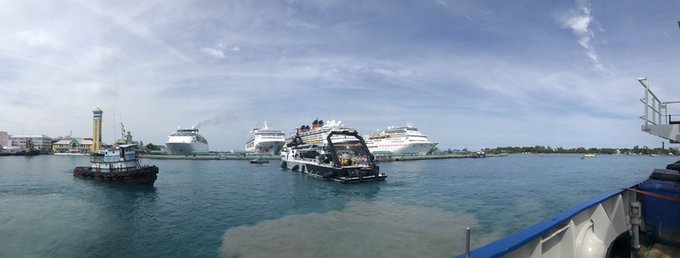
Our current pace with the ship should bring us at our first station on the 5th of February – somewhat later than scheduled – where we will start our scientific sampling frenzy. Some setbacks were encountered before embarking on this expedition. Yet, from a “glass-half-full” perspective, it is good that we encountered these before actually setting sail. Unfortunately, we had to exchange cooks, as some more important family matters occurred for our initial cook. Also, one of our fellow scientists (Yord) found out that a hand infection was worsening. After some minor surgery (all is well!), he needed to stay behind in Nassau in the Bahamas. The rumor is going around that Yord will still write the next blog from the hospital.
While waiting for arrival at our first station, the rest of the scientists are using their time by setting up the lab spaces, presenting scientific backgrounds and goals, discussing and updating the sampling plan (done!), and just existing. We have to be patient…
Rick Hennekam
Day 2: February 2 – by Yord IJedema
Doctor’s hospital, Nassau, Bahamas
So a few months back, you got yourself an awesome PhD position on organic carbon transport in the Gulf of Mexico. Great! You hear that there is fieldwork with the Pelagia involved. Terrific! Due to an unexpected gap in the ships schedule, you can actually do this fieldwork during the first month of your PhD. You only have to graduate in time and make sure that your contract starts a few days earlier. Done? Perfect. Now you have time to make everyone jealous that you go to the Bahama’s, meet up with your lovely group of scientists and prepare in anticipation of this wonderful journey.
The only troubling thing is that your hand starts to hurt a bit a week before departure. That’s probably because you work out too much and over-trained a tendon. Bummer. The hand now also starts to swell a bit, so you visit a doctor who thinks you got unlucky and caught a bacterial infection in a tiny wound that you would hardly notice, so you get antibiotics with you for ten days. Not too bad, with some luck your hand is normal and in full use again before the ship has reached the first coring site. But unfortunately, the swelling does not stop and the redness only increases, as you’ve already landed in Nassau. So you start your official first working day with a visit to the doctor, as the ship has to wait two days on the arrival of the new cook.
And then the doctors hit you with an ultimatum; or immediately fly back to the Netherlands, or get your hand operated here and stay in the hospital for five days, which was much more recommended as a few days later, it likely would have evolved into sepsis. Either way, you’re not going on that ship. …
…
…
…
…
(lively description of my initial reaction).
Well yes, how do you recover from that? For the physical part, quite okay. The operation went well and the infection seems to be almost gone. It is now a few days later and I hardly have any pain, although it will probably take a while before I can use this hand fully again. Tomorrow I will fly home, so I can focus on my recovery there. And luckily the insurance will cover my costs. For the mental part, I don’t know yet, but with every picture you see from the ship, you cry a little inside, although I really hope they keep sending them.
The hardest part is probably explaining to everyone in Utrecht why you are back early, or meeting everyone on the ship for half a day and then having to leave them behind (or rather the other way around). Well, at least you have the most interesting first day of a PhD that you know of, and everyone on the ship is miserable at the moment due to sea sickness. It’s the little things. For everyone still on the ship, bon voyage and I hope to see you soon in the Netherlands (or somewhere else Torbjörn). Also, I hereby volunteer to go on the next Pelagia cruise.
Best regards to everyone.
PS. Oh, you expected science in a science blog? Ehr, the climate is warming. Good night!
Yord IJedema
Day 5: February 5 – by Francesca Sangiorgi
Somewhere offshore Louisiana
We left Nassau (Bahamas) on January, 31st at 11 am. A brief and not too difficult calculation made us realize we had just started a very long transit: 1200 miles, 10 knots speed (10 miles per hour), 120 hours, exactly 5 days … 5 days? What can 9 scientists do on a boat during 5 days transit?
Each day on the R/V Pelagia is paced by breakfast (at 7 am), lunch (at 12.30 am), dinner (at 6 pm). Eating rituals are quick and efficient, eating is not quite seen as a pleasure when you are on a ship, although the food prepared by our cook HendrikJan is delicious. Eating is rather seen as a way of surviving. Each meal takes about 20 minutes, and the days (on transit) are very long.
But scientists are full of great ideas … so here is how we spent our time.
Day 1: the day went by quite quickly, sharing some ideas, getting acquainted to the ship and the life on board. The evenings after dinner are a great opportunity to share scientific background, projects, science plans, goals to be achieved with this expedition and beyond. Torbjörn, Geology professor at Tulane University, and Wesley, MSc-student Marine Sciences at Utrecht University, were the first on stage. Torbjörn talked about the Mississippi fluvial deltaic sediments and their high potential for carbon storage. Wesley introduced his project, a combination of palynology and lipid biomarker analyses to trace terrestrial organic molecules to the marine environment. The project uses surface sediment samples collected 2 years ago along a transect offshore the Atchafalaya river (branch of the Mississippi) during the NICO (Netherlands Initiative Changing Oceans) Leg 7 expedition.
Day 2: activity kept going. Reading papers, discussing sampling strategies, catching up with work left behind. A great opportunity to exchange ideas and talk about past, present and future science. Francien (organic geochemist at Utrecht University) and I (palynologist at Utrecht University) are happily sharing the office.

In the evening, Laura, a NESSC-researcher working at NIOZ, presented her PhD project on calcification of benthic foraminifers and her ultimate target to find a proxy for CO2 and pH. Zeynep (postdoc in organic geochemistry at NIOZ and sea-going expeditions expert) shared with us some results of the NICO Leg 7 expedition.
Day 3: the day was “easily” filled: seasickness kept us busy. Someone (like me) slept 22 hours, someone provided repeatedly fresh food for fish, all of us looking like zombies the day after. No pictures available of this day.
Day 4: as the sea calmed down, activity picked up. The day started with a coffee (or a tea) on the deck waiting for the sunrise. While Rick Hennekam (postdoc in paleoceanography at NIOZ) was trying to find a highly organic geochemistry-oriented paper interesting, Kristin, a PhD at NIOZ, decided it was time to prepare the material for sampling, label bags and vials.
In the evening’s presentation round, Rick talked about the power of XRF scanning marine sediments and Kristin explained her research project on dynamics of hypoxic and anoxic environments and the complex incubation experiments she is setting up on board.
It was then time for a mega tournament! We all played a game call ‘ass’, while sitting in the wet lab, enjoying the mild temperatures outside … Laura won easily the first 5 rounds, then a quick look into each other’s eyes, and the strategy changed. You get to let the chief scientist win, right? Surprisingly, Francien defeated us. 🙂
Day 5: Alena and Laura decided to take action and start prepping material for their sampling: endless writing codes on plastic bags, and bottles, while drinking Coca Cola to stay awake.
In the evening it was my turn to talk about primary production, eutrophication in coastal areas, Harmful Algal Blooms (HABs). I made a wish: reconstruct past HABs of Karenia brevis (the nasty dinoflagellates causing toxic blooms each year in the Gulf of Mexico). We shall see. Francien explained her goals and related challenges of tracing the terrestrial organic molecules into the marine sediments. To conclude the round of presentations, Alena, a PhD candidate at NIOZ, presented her project on the characterization of microbial communities in marine sediments with a focus on Woeseiales.
We missed Yord, the youngest NESSC PhD candidate, who started his PhD at Utrecht University, as his project is tightly related to the expedition.
The bell rings, time for lunch!
Francesca Sangiorgi
Day 6: February 6 – by Alena di Primio (PhD-student at NIOZ)
First day of sampling – a muddy experience
Before I begin, let me establish 3 things:
- I’m a microbiologist by training.
- I have two things I really need to be clean: my kitchen and the lab I work in, everything else comes second.
- I’m the only microbiologist on board…
The day starts with anticipation. Finally we will have something do to other than sit around and write blog entries or play card games, though the PIs did get proper work done. So after a quick breakfast we all rush outside at 7:45 am to find that the nice temperature of 20 ͦC that we had the first week, has changed overnight to 7 ͦC. So we all rush back inside to get more layers on top the existing ones. The station we’re at is the first on the transect along the plum of the Atchafalaya river along the coast of Louisiana. The depth at this point is around 20 meter so sampling should be quick. The CTD starts going down and within 5 minutes, it’s back up with the first water samples. While the crew was working, all the scientists were standing in the way – a common start as I was told. Now we go on to the truly exciting part: The Multicore!
We enthusiastically have 12 tubes loaded, and the preset weight on top. We let it go down, it does what it’s designed for, we get it up … and we see a bunch of basically empty tubes. All the excitement from earlier is gone. So we have the crew load on more weight and drop it again. This time we have cores of 5-10 centimeters – not good enough. We put on maximum weight and decrease the number of tubes to 8 – down and up again: We finally have acceptable samples! The excitement is back.
My excitement is quickly turned into something else (confusion) as Kristin, Zeynep, and Francien start mashing the sediment which dropped out from the cores between their fingers and smell it. Later I was told that Torbjӧrn even TASTED it (I’m disgusted!). Then they start analyzing the grain size and color with the others and I’m standing there not quite able to grasp how they suddenly went from sophisticated scientists to people playing with mud. But the work continues and we start getting into it. I help with operating the hydraulic core slicer and together with Laura, Francesca, and Wesley we get everything neatly packed.
The second smaller shock comes when in order to clean spatulas and rings, they use water instead of ethanol! My world is at this point being turned upside down. I was taught that Ethanol is your best friend when it comes to cleaning material, and here they go and use water. At one point it’s also clearly not clean anymore as the sediments turn it muddy and they still keep on using it! How is this supposed to result in good clean samples? Everything has got to be contaminated at this point, right? Well, the first sampling still finishes even with me worrying about contamination and we go and have lunch.

During lunch we arrive at the second station and it starts all over again. 8 tubes, 20 meter, full weight, CTD down and up, multicore down and up, scientists are playing with mud again, I’m still confounded. We start slicing and proceed with a minor interruption of Zeynep purposefully putting a mud smudge on my cheek which I did not appreciate tremendously if I’m being honest. After cleaning my face we still finish with some spare time before dinner. At this point the wet lab is a mess in my eyes, so I do what I must and clean up. This state of dirt would never be acceptable in a microbiology lab. NEVER! I wipe the tools and working space with Ethanol, put everything where it belongs and make sure that I have everything prepared for the next station. Things are somewhat sterile again and I’m happy. My happiness isn’t allowed to last for too long though as the third station approaches and the muddy mess ensues once more. Once more the routine, once more playing with mud, once more I clean up after, and finally somewhere around 9 pm we call it a day.
The next morning I wake up, accept my fate, and start playing with mud with the others (though with smaller quantities and less enthusiasm).
Alena di Primio
Day 8: February 8 – by Torbjörn Törnqvist (Geology professor at Tulane University)
(Almost) coming home
Our sampling campaign started for real on a chilly Thursday morning off Galveston, Texas, and then took us eastward along the Louisiana coast. This region is not only home to me; over the past few decades I have spent numerous field campaigns in the expansive wetlands right across the shoreline. Naturally, I am eagerly looking for land, especially after the fresh blast of Canadian air eventually brought us chilly but calm winter weather, including generous sunshine. We enjoy some of the clearest views of the horizon that one can get in this part of the world. But all I see is ocean, peppered with oil & gas platforms. When we get closer to the mouth of the Atchafalaya River, one of the target areas of the expedition, I go up to the bridge to borrow binoculars. I try to take advantage of the height to spot the most striking topographic features that are out there along this part of the coast: a line of salt domes known as “The Five Islands.” They are like small mountains in this otherwise nearly flat terrain. One of them is Avery Island, where Tabasco comes from. But no matter how hard I peek, there is nothing in sight. Granted, we are tens of kilometers from the shoreline so it’s quite a distance, but still… This is when I’m reminded that we are tracking one of the lowest-lying coastal zones in the world, with most of the land just a few decimeters above sea level. As a result, this coast is also among the most vulnerable: it loses wetlands at a rate of about one football field every 100 minutes.
When I was asked a few months ago if I wanted to join this cruise, I didn’t need much time to think about it. It was clear that this expedition contained a lot of elements that intersected with and complemented my interests. My initial response was whether it would be possible to join for just one week (perhaps I imagined some sort of spectacular drop-off and pick-up by helicopter?). Thankfully, that was not an option – you either participate for real or you don’t.

Over time, my research interests have slowly crept more and more toward the ocean. One of my most recent papers came out in Ocean Science, so perhaps getting out on an oceanographic cruise was inevitable. Over the past few years, the work within my group at Tulane University in New Orleans has started to consider organic carbon fluxes and burial, in and around the Mississippi Delta. All of this work has focused on areas that are currently land, while we know that a large portion of the carbon that flows down the river ends up in the ocean. As a result, it wasn’t hard for me to get excited about this cruise, since studying the sources, pathways, and burial of organic carbon in Gulf of Mexico sediments is one of its main objectives. Along the lengthy transport path that is the Mississippi River, some of the carbon may be returned to the atmosphere as carbon dioxide and contribute to further global warming and sea-level rise. These are potentially life or death issues for areas like coastal Louisiana that we need to better understand.
One of the great things about expeditions like this one is the amount of time available to talk science and kick around new ideas, in ways that are just different from the rushed skype meetings and hectic mega-conferences that seem to dominate the lives of scientists these days. There is no better way for new collaborations to take root. We are a multidisciplinary science team, strikingly young in age (not counting myself!), but with nine of us we are also easily outnumbered by a crew of 13. The Pelagia crew is a phenomenal group of people, many of them with intriguing life stories filled with adventure. Our masterful cook Hendrikjan Lokhorst, who flew in last minute from his home base in Athens to join this expedition, is treating us to new culinary surprises every day – greatly surpassing my expectations that looked more like “scheepsbeschuit” and dried meat. For example, it didn’t occur to me that I would enjoy an appetizer of Dutch shrimp (topped off with a particularly delicious sauce) while sailing among Louisiana’s Gulf shrimp. So one lesson learned: if you want to lose weight, these research cruises are dangerous!
Between all the busy work, there are still enough moments to take in spectacular sunsets, watch pelicans sailing by, and follow dolphin families jumping and playing around our ship. It’s an odd feeling that while I write this and enjoy the peaceful scenery, Mardi Gras is ramping up back home in New Orleans, with the legendary Krewe de Vieux parade about to roll – only a few hours away.
Torbjörn Törnqvist

Day 17: February 17 – by Laura Pacho
A drink of seawater
This story has two phases. The first is before entering the Pelagia, and it begins at NIOZ when Gert-Jan told me that I could go on an oceanographic campaign. It was a golden opportunity to go onboard and collect samples for my doctorate just two and a half months after starting my PhD. But there was a problem: I get dizzy on boats. I was afraid that the dizziness would be constant throughout the trip and wouldn’t let me work or be torture. In the end I decided to go, why not try? I still knew that the work would be complicated since one of my functions would be to work with ethanol, and anyone who has been dizzy on a ship knows that strong odors are the worst of the world. I decided to prepare well, and of course take a pharmacy with me.
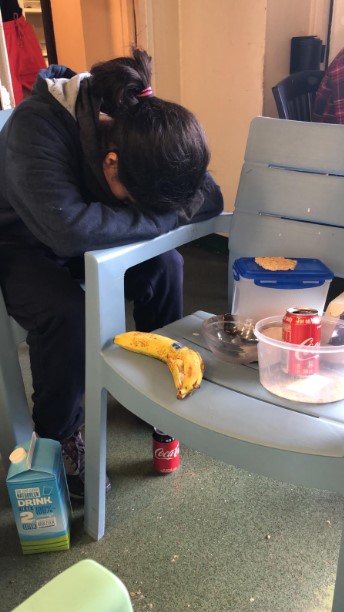
The second part of the story begins when our ship, the Pelagia, sails from Nassau towards the Gulf of Mexico, near the Mississippi. There are five days of transit, that each person begins, as it so happens, mainly advancing work on their computers. The first two days are full of smiles, good humor and getting used to this wonderful ship. Then the third day arrives: the ship moves as if it were a washing machine, I get up in the morning and without thinking twice I go to the WetLab instead of the dining room, and I find the faces of two of my colleagues, Kristin and Alena, who are in a no better shape than I (well maybe a little better). I vomit once, twice, thrice, and even a fourth time. The whole crew gives me advice on what to do, and I follow them all, just in case. My colleagues bring me crackers, water, soda, soup, they behave incredibly well with me, always taking care of the fallen. I spend absolutely all day sitting in a chair with my head down. But the next day it turns out that I’m fine, the seasickness pills work.
We started working on sampling on the sixth day, in my case, collecting samples of benthic foraminifera. In the sediment cores there was always a layer of water that we decided to remove with the help of a tube. For this one had to suck in the air from one side while the other end was emerged in the water. And yes, I drank and savored the very salty water of the Gulf of Mexico (several times). And I thought the worst was going to be the ethanol.
Today, as I write this, we are on our way back to Nassau. I have to stop writing here, because yes friends, the dizziness has returned to my life after sampling. These have been days of hard work, and a lot of fatigue, but also many smiles, and of exceptional people who despite being exhausted continue to help in the collection of samples. Without a doubt and despite the dizziness days, this has been one of the best experiences I have had, and certainly of great importance for my doctorate. Thanks to all my companions on this trip and the crew that I got to know, that made everything better on this wonderful ship, the Pelagia.
Laura Pacho
Day 19: February 19 – by Francien Peterse
Looking back & wrapping up

When I learned last November that I had the chance to take the Pelagia to the Gulf of Mexico I had no idea that everything would work out so well. Normally, it takes more time to plan and prepare for a research expedition – permit requests need to be submitted 6 months in advance, for example. But here we prove: if really you want something to happen, you can make it happen.
Our cruise plan was based on the program that we initially made for the Netherlands Initiative Changing Oceans (NICO) expedition in 2018. At that time we could not carry out most of the program due to endless waiting for the arrival of a container with equipment, a really long transit to the Gulf, and bad weather once we finally started sampling. This time I was determined to visit all the sites on the program and collect as much material as we could store on the ship. I even had the marine facilities at NIOZ send extra freezers and fridges over for more storage space. In the mean time we also had obtained funding for a PhD project on ‘The fate of terrestrial organic carbon in the marine realm’, designed for the samples that we would collect during this expedition, from the Netherlands Earth System Science Center (NESSC). The pressure was on!
Sure enough, we encountered the first hiccups in Nassau, with a last minute crew change and the hospitalization of Yord (the (un)lucky PhD student on this project, read his earlier blog post), followed by a day of sea sickness of practically all scientific participants once we finally left port. As soon as we fully entered the Gulf, the sea calmed down, the sun came out, and luck was on our side again. This appeared to be one of those magical expeditions where everything seems to work out: we visited all stations according to the plan, collected all samples on our wish lists, piston cores came up full, and even managed to squeeze in two additional sites that came up during our scientific discussions while slicing the multicores. In total, we have visited 21 stations, deployed the multicorer 37 times, retrieved a total of 45.91m piston core, collected about 4000 sediment samples, filled over 250 bottles with rose Bengal to stain living benthic foraminifera, and labeled >4500 vials for porewater collection. Clearly enough material to fill a PhD thesis with (or more than one, actually)!
Our success was first of all made possible by the crew of the Pelagia, who were always ready to deploy whatever instrument we desired, or to sail the extra mile(s) for a new sample location. The smooth operation of the scientific sampling machine was the second ingredient of our success: Zeynep and Alena took care of the multicorer as soon as it got on deck, Francesca, Torbjörn, Laura, Wesley, and Alena formed the core slicing team (with cries of victory when the hydraulic slicer with 0.1mm scale was stopped at the exact sampling depth), Rick and Zeynep managed the piston cores, Laura shook each of the bottles filled with rose Bengal for at least 1 minute, and Kristin was hidden away in her container on the back deck to fill all the nicely labeled vials with pore water under the anoxic conditions in the glove bag.

In between sampling we had fun with our spontaneous ‘guess-the-salinity-at-the-next-station’ competition. The close vicinity of our sample sites to the Atchafalaya and Mississippi Rivers ensured that the salinity of the surface water was different at every station. The crew also participated and became more and more competitive at each station. In the end, the competition was between Barry, representing the deck crew, and scientists Francesca and Rick. After (almost correctly) estimating the salinity of a salt water mixture (24 psu) that we had prepared in the kitchen, Barry turned out to be the well-deserved winner of the one and only GoM2020 Salinity Award.
I have very much enjoyed this cruise, and I hope that the data will turn out to be as nice as it was collecting the samples.
Francien Peterse






